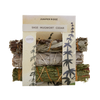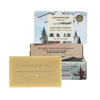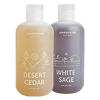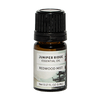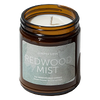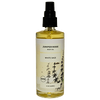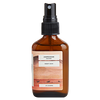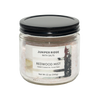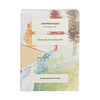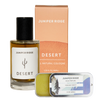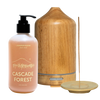
Two of the many reasons I love early summer make me think I might be a bear. Like, the animal kind, a grizzly. I could live solely on salmon and blueberries. Freshly caught salmon and sweet, plump blueberries are my favorite eats on the trail. Let’s dive deep into what makes this the best dinner of the season.
Ingredients
- Choosing Your Fish. Buy high quality, wild line-caught Chinook salmon. Don’t mess with farmed salmon or the vastly inferior Coho salmon, also called silver salmon. Farm-grown looks beautiful but tastes insipid and isn’t ecological in any way. Coho/silver/chum are way cheaper, but they don’t have the richness or complexity of Chinook salmon, which has two to three times the fat content of other species. It used to be true that only Chinook was considered fit for human consumption, and the others were used to make dog food. Animal fats, especially if they come from free range and wild animals, aren’t the type of fats you should be concerned about. Salmon fat is off-the-charts good-for-you because it’s so dense with omega-3 fatty acids: good for your brain and anti-inflammatory. Salmon fat is dietary gold and you should be consuming lots of it.
The fish you buy should be firm and pink. (Quick tip! Don’t let them give you the one with the full glaze that’s sitting on top of the fish pile, they’re just trying to get rid of it. The best salmon is usually at the bottom of the pile.) Light pink indicates high quality, early season fish. If it’s more red and loose, it’s late season/river run salmon. These salmon (called June Hogs in the northwest) are at the end of their lifecycle and at the beginning of falling apart. Not good. The amazing, sustainable Copper River Run in Alaska produces high-quality, early season salmon well into the summer months.
- Choosing Your Blueberries. Do this right. Please, don’t bother with southern lowbush blueberries. Those are the ubiquitous ones you see in big box grocery stores. Get organic, northern highbush blueberries. (Quick tip! Blueberries grow best in environments with deep winter climates. If they come from the northwest or other cold climates, they the good kind.) They’ll cost more and taste better; buy them.
Curing and Cooking
- Curing: A few days before you’d like to serve your salmon, cure it. (I think you get optimal flavor after curing for three or four days, but you should experiment and decide what tastes best to you.) Japanese style fish curing can give salmon a tremendous umami flavor and satisfying crisp texture. Using a ratio of 1 teaspoon of salt per pound of fish, rub salt in vigorously. The salt will do two things: initially, it’ll drain water out of the salmon and create delicious flavor density; then the salt will begin to move into the center of the fish by osmosis. Science!
Once you’ve salted the fish, place it in a container that will collect the water (like an open pit or large ceramic bowl) and put it in the fridge uncovered. As the salt drains the salmon of water, pour out the excess water daily. Make sure the salmon stays elevated above the liquid so it’s not reabsorbing the liquid. (Remember this flavor densification process is where those yummy umami crystals come from. You want the moisture to evaporate.) The salt will work its anti-biological, food-preserving culinary magic and your salmon will be fully cured in a day or two. Once it’s cured, it’ll remain good for cooking for up to two weeks.
(Note: You’ll know you’ve waited too long to cook it if it starts to smell a little… off. I’ve never had this happen with salt-cured fish, even after two weeks. You don’t need experts telling you how long seafood lasts in your fridge. Trust your animal senses! We’re built to do this, it’s deep in our DNA. The survival of our species relied on this kind of stuff. Just ten seconds ago in our evolutionary history, we were catching and preserving food way before refrigeration was even imagined. If it’s gone bad, you’ll know.)
-
Cooking: Primal is Best. When you’re ready to cook the salmon, do it over an open, wood-fire
flame. The obvious, simplest way is to use natural wood briquettes in a BBQ.
Take the salmon out of the fridge a few hours before cooking to bring it up to room temperature. Otherwise, you run the risk of it overcooking the outside and leaving it raw inside.
Cook it covered, using super-indirect heat (as little charcoal/firewood as you can) for about 30 minutes or so. The goal is to bring up the temperature of the salmon slowly and evenly, throughout the whole cut of fish. Cooking for slowly, for the longest period of time possible will allow the smoke to really infuse into the fish. This is a beautiful piece of fish you’ve been taking nurturing for several days, please be careful here and don’t overcook it!
It’s hard for me to tell you exactly how long you should cook it because there’s no way for me to know the temperature you’re working with. Keep in mind, the meat gets tougher the longer you cook it. Use a fork or your finger to press down on the salmon; it should feel loose. If it feels super tough, remove it from the heat and cut into it to see what’s up.
I said 30 minutes, but you want to cook it over indirect heat until it just starts to tighten up. It’ll be cooked on the outside and translucent in the middle. The goal here is to get it 99% cooked via indirect heat. Then add piles of charcoal/firewood and get that fire good goddamn blazing hot. Put the salmon on for about 45 seconds on each side and sear. This hot-heat will tease out the caramelized fat flavors. Think caramelized, not charred black. You want that delicious skin bubbling and deep brown.
-
Oh yeah, dessert. As for the blueberries, keep it simple. Rinse them and garnish with high
quality, organic crème fraîche and maple syrup to taste.
That’s good summer eatin. Chow.


